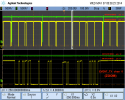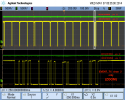We found out, that in our
multichannel configuration strange EVENT_TX behaviour can be observed.
We SPORADICALLY get EVENT_TX (at MASTER side, channel 0) missing (detected by software, successfull oscilloscope's catch shows this drop too) for
tens of seconds (!).
Our test application includes LED blinking on EVENT_TX or received Broadcast (both on channel 0 only), so when master channel 0 transmits, we can see LED toggling. When no EVENT_TX comes, LED is OFF.
When EVENT_TX drop out is long lasting, we can send single broadcast from slave, and LED blinks once, so RF link is OK, and Antware slave ALL THE TIME shows
Received BROADCAST_DATA_0x4E too (so channel 0 hasn't been and is NOT closed).
ANT protocol: EVENT_TX occurs when the ANT device has successfully transmitted a broadcast message, the EVENT_TX message can be used to prompt the master MCU that ANT is ready for the next data packet.
Our config:
ANTAP281M5IB module rev. H (
latest, ANT Version returns AP2-8 1.09), asynchronous bus with MCU at 50000Bd (regular EVENT_TX takes approx. 1,4ms), low power operation with SLEEP mostly in log. HIGH
RTS checked, two zero pads applied
channel 0: bidir master (1-116-69) at 4Hz, 2457MHz,
ANT+ network 1
channel 1: bidir slave (1-116-5) at 16Hz, 2477MHz, ANT network 0
channel 2: bidir master (1-116-69) at 4Hz, 2477MHz, ANT network 0
What could block the EVENT_TX on channel 0? (MCU normally sends EVERY slot /4Hz/ broadcast to AP2 channel 0, when EVENT_TX on channel 0 occurs, but when no EVENT_TX is transmitted by AP2, Tx line from MCU to AP2 is
clean/still in log. HIGH/, so no traffic jam on bus. Antware scanner still shows, that channel 0 (and also channel 2)
is transmitting and when broadcast is sent from Antware (slave) to our config (ANT+ master at channel 0), LED blinks once.
The counting of EVENT_TX is crucial to comply with ANT+ profile.
Scoping AP2 Tx and Rx lines shows, that EVENT_TX from channel 0 IS MISSING, while receiving broadcast from channel 1 and also EVENT_TX from channel 2 NORMALLY OCCURS.
This strange behaviour happens with different pieces of our hardware (always AP2 rev. H populated), so it's repeatable.
It looks like an event filtering occurs, but this feature is NOT available in AP2 family. Or some collisions?
Image Attachments


Click thumbnail to see full-size image

